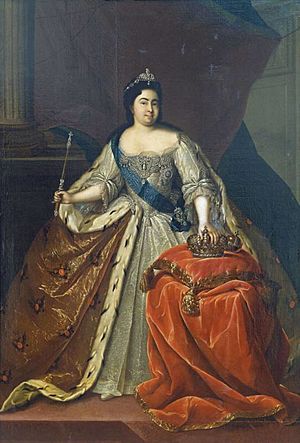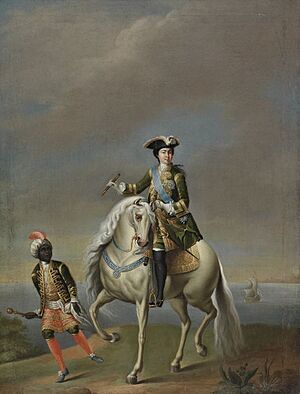Catherine I of Russia facts for kids
Quick facts for kids Catherine I |
|||||
|---|---|---|---|---|---|

Portrait by Jean-Marc Nattier, 1717
|
|||||
| Empress of Russia | |||||
| Reign | 8 February 1725 – 17 May 1727 | ||||
| Coronation | 7 May 1724 (crowned as co-reign) | ||||
| Predecessor | Peter I | ||||
| Successor | Peter II | ||||
| Empress consort of Russia | |||||
| Tenure | 22 October 1721 – 8 February 1725 | ||||
| Born | 15 April 1684 | ||||
| Died | 17 May 1727 (aged 43) Tsarskoye Selo, Saint Petersburg, Russian Empire |
||||
| Burial | Peter and Paul Cathedral | ||||
| Spouse | |||||
| Issue among others ... |
|
||||
|
|||||
| House | Skavronsky (by birth) Romanov (by marriage) |
||||
| Father | Samuel Skowroński | ||||
| Mother | Elisabeth Moritz | ||||
| Religion | Russian Orthodox prev. Lutheran and Roman Catholic |
||||
| Signature |  |
||||
Catherine I (born Marta Helena Skowrońska) was a remarkable woman who became the Empress of Russia. She was the wife of Peter the Great, one of Russia's most famous rulers. After Peter's death in 1725, Catherine ruled Russia until her own death in 1727. Her life story is quite extraordinary, showing how someone from humble beginnings could rise to become a powerful empress.
Contents
Catherine's Early Life
Catherine was born on April 15, 1684. Her original name was Marta Helena Skowrońska. She was the daughter of Samuel Skowroński, a farmer from the Polish-Lithuanian Commonwealth. Her parents passed away when she was very young, around 1689.
At about three years old, Marta was taken in by an aunt. She was then sent to Marienburg, which is now Alūksne in Latvia. There, she was raised by Johann Ernst Glück, a Lutheran pastor. In his home, Marta worked as a servant. She never learned to read or write.
Marta was known for her beauty. When she was seventeen, she married a Swedish soldier named Johan Cruse. However, they were only together for eight days in 1702. Soon after, Russian forces captured Marienburg.
Marta later became part of the household of Prince Alexander Menshikov. Menshikov was a close friend of Peter the Great. In 1703, Peter met Marta while visiting Menshikov. By 1704, she had become an important part of Peter's life. She also converted to Orthodoxy and took the name Catherine Alexeyevna.
Marriage and Family Life
Catherine and Peter the Great secretly married sometime between October and December 1707. They had twelve children together. Sadly, most of them died young. Only two daughters, Anna (born 1708) and Elizabeth (born 1709), lived to adulthood. Elizabeth later became Empress of Russia herself.
Peter had moved Russia's capital to St. Petersburg in 1703. While the city was being built, he and Catherine lived simply. They stayed in a small log cabin. Catherine cooked and cared for their children. Peter even tended a garden, like an ordinary family. Their relationship was very strong and loving. Many letters show the deep affection between them. Catherine was known for being energetic, kind, and cheerful. She often helped calm Peter when he was angry.
Catherine's Bravery in Battle
Catherine even joined Peter on his military trips. In 1711, she went with him on the Pruth Campaign. During this campaign, Peter and his army were surrounded by many Turkish soldiers. Catherine suggested using her jewels and those of other women to bribe the Turkish leader. This plan worked, and the Russian army was able to retreat safely. Peter gave Catherine full credit for saving his army.
Because of her bravery, Peter officially married Catherine again. This second wedding took place on February 9, 1712, in St. Petersburg. Catherine became Tsarina, and when Peter declared Russia an Empire, she became Empress. Peter even created a special award, the Order of Saint Catherine, in her honor.
Catherine's Children
Catherine and Peter had twelve children. Most of them passed away during childhood. The two who survived were:
- Grand Duchess Anna Petrovna (1708–1728)
- Grand Duchess Yelizaveta Petrovna (1709–1762)
Catherine's Siblings
After Peter's death, Catherine found her four siblings. She gave them new titles and brought them to Russia.
- Krystyna Skowrońska, renamed Christina Samuilovna Skavronskaya. Her family became the Counts Gendrikov.
- Anna Skowrońska, renamed Anna Samuilovna Skavronskaya. Her family became the Counts Efimovsky.
- Karol Skowroński, renamed Karel Samuilovich Skavronsky. He became a Count of the Russian Empire.
- Fryderyk Skowroński, renamed Feodor Samuilovich Skavronsky. He also became a Count of the Russian Empire.
Becoming Empress of Russia
Catherine was crowned Empress in 1724. Peter the Great died in January 1725 without clearly naming who should rule next. Catherine had strong support from the "new men." These were people Peter had promoted to important positions based on their skills, not their noble birth.
During a meeting to decide the next ruler, Catherine's supporters, including Menshikov, helped her become Empress. The powerful guards regiments, who liked Catherine very much, declared her the ruler of Russia. However, the real power was shared with Menshikov and other members of the Supreme Privy Council.
Catherine's Reign and Legacy
Catherine I ruled for two years, from 1725 until her death on May 17, 1727. She passed away in St. Petersburg at the age of 43. Before she died, she named Peter II, Peter the Great's grandson, as her successor.
Catherine was the first woman to rule Imperial Russia. Her reign opened the way for other powerful women to rule Russia for almost a century. This included her daughter Elizabeth and her granddaughter-in-law Catherine the Great. These empresses continued Peter the Great's efforts to modernize Russia.
At the time of Peter's death, Russia had a very large army. However, keeping such a big army was very expensive. It used up about 65% of the government's money. Since Russia was at peace, Catherine decided to reduce military spending. This decision helped ease the tax burden on ordinary people. Because of this, Catherine I gained a reputation as a fair ruler.
The Supreme Privy Council was a new government body. It helped to focus power in the hands of a few key people. In foreign affairs, Russia joined an alliance with Austria and Spain. This was to protect the interests of Catherine's son-in-law, the Duke of Holstein.
Catherine left a lasting mark on Russia. She gave her name to Catherinehof near St. Petersburg. She also built the first bridges in the new capital city. She was the first royal owner of the Tsarskoye Selo estate. The famous Catherine Palace there is named after her.
She also gave her name to the Kadriorg Palace in Tallinn, Estonia. This palace means "Catherine's Valley" in German. Today, it houses the Presidential Palace of Estonia.
Overall, Catherine's rule was sensible and careful. Her story, from humble beginnings to Empress, was so unique that later rulers kept it a secret.
See also
 In Spanish: Catalina I de Rusia para niños
In Spanish: Catalina I de Rusia para niños
Images for kids




